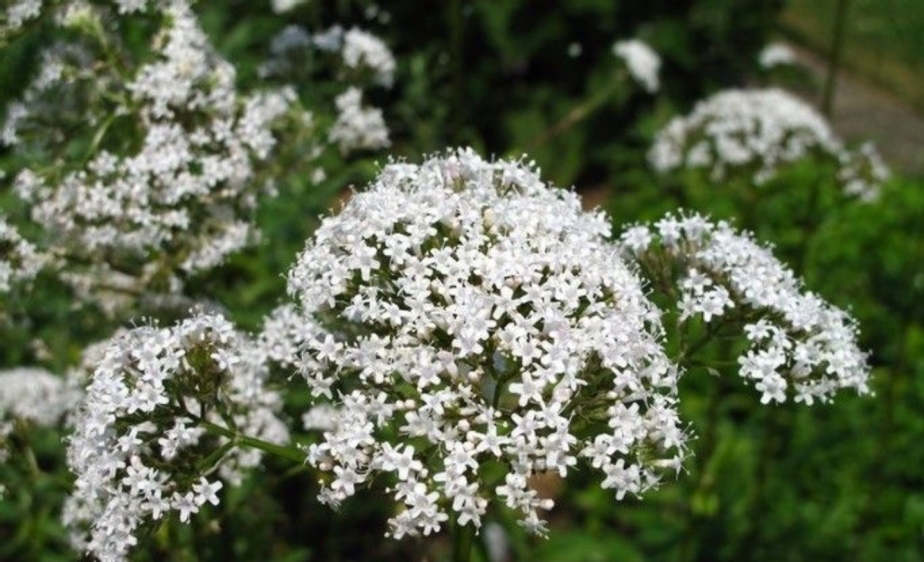Valerian plant is known to help those who take it …relax, take a nap, and let loose. This plant focuses on the nervous system and can be used as a mild sedative. Be aware that most people do not like the smell of this flower; some claim it smells like sweaty socks!
Scientific name: Valeriana officinalis: The name is from Latin ‘valere‘ which means to be strong or healthy.
Parts Used: Root, Rhizome, herb
Planet: Mercury
Element: Water
Main Constituents: Volatile oils, valepotriates, akaloids
Actions/Medicinal Properties: Sedative, hypnotic, nervine, antispasmodic, expectorant, diuretic, hypotensive, carminative, milldly analgesic.
Dosage:
- Soaked in cold water for up to 10 hours: drink 1 cup strained water/tea up to 3 times daily for anxiety, nervous tension or blood pressure related stress. Take 1 cup before bed for insomnia.
- Tincture: take 1tsp (1-5ml) up to 3 times daily for nervous problems. Doses can vary between individuals. Sometimes high doses can cause headaches for some; so it’s best to start with small doses. If taking other forms of medication, check with your doctor prior to consuming this tincture. Will not usually cause drowsiness/grogginess unless you are also taking other medications.
- Compress: soak a pad in a cup with maceration or tincture and apply to muscle cramps or abdomen during period pains and colic.
Magical Properties: Protection; purification; restfulness; calmness; grounding; love and harmony.

Valerian is a well-known relaxant and is useful when muscle tension combines with anxiety or sleep problems. It relaxes smooth muscle spasms and cramping.
Most of the benefits are stored within Valerian’s volatile oils. Many find the tea tastes disgusting and the smell is disgusting (…think gym socks, yuck!) but many will struggle through that smell and taste for it’s amazing benefits!
As Nature it ordain’d its own like hurt to cure,And sportive did herself to niceties inure.Valerian then he crops, and purposely doth stampTo apply unto the place that’s haled with the cramp
Poet Michael Dayton
Although it is a fairly safe species its use is not recommended for extended periods of time and it should be used with caution for those suffering from liver failure. Not recommended for pregnant or nursing women, or children under the age of 12.
Valerian Through History
During medieval times in Sweden, many grooms wore Valerian to ward off the envy of elves on their wedding day, or leading up to their wedding days.
Most of us have heard the tale of the Pied Piper of Hamelin, Germany who played his flute and led the rats out of town forever. Many feel the Pied Piper must have been familiar with valerian and put it in his pockets or rubbed himself with it. Rats love the smell, and it may have been the valerian, not the music, that enticed the rats to follow him!
The Nordic goddess Hertha is said to have used valerian as a whip to encourage the stag she rode to greater speeds.
In magic, it was used in love potions, and in Sleep Pillows.
Some people claimed that if valerian was thrown where people were fighting, they would cease immediately and that it could be used to tame the wildest of beasts.
The ancients Greeks would hang bundles of valerian in their homes, especially in their windows, to keep evil entities from entering. The Celts believed hanging it their homes would keep lightening from striking.
In the wizard world of Harry Potter, valerian was believed to have soporific qualities and was given in teas to encourage sleep.
It was generally regarded as a feminine element. Its powers were believed to be love, sleep, purification, and protection.
In addition to a sleep aid, valerian has been used for anxiety, stress, to treat addictions, convulsions, gas, pain, hyperactivity, intestinal cramping, migraines, aggression, nervous exhaustion, coughs, epilepsy, and the flu. And the list goes on and on…


